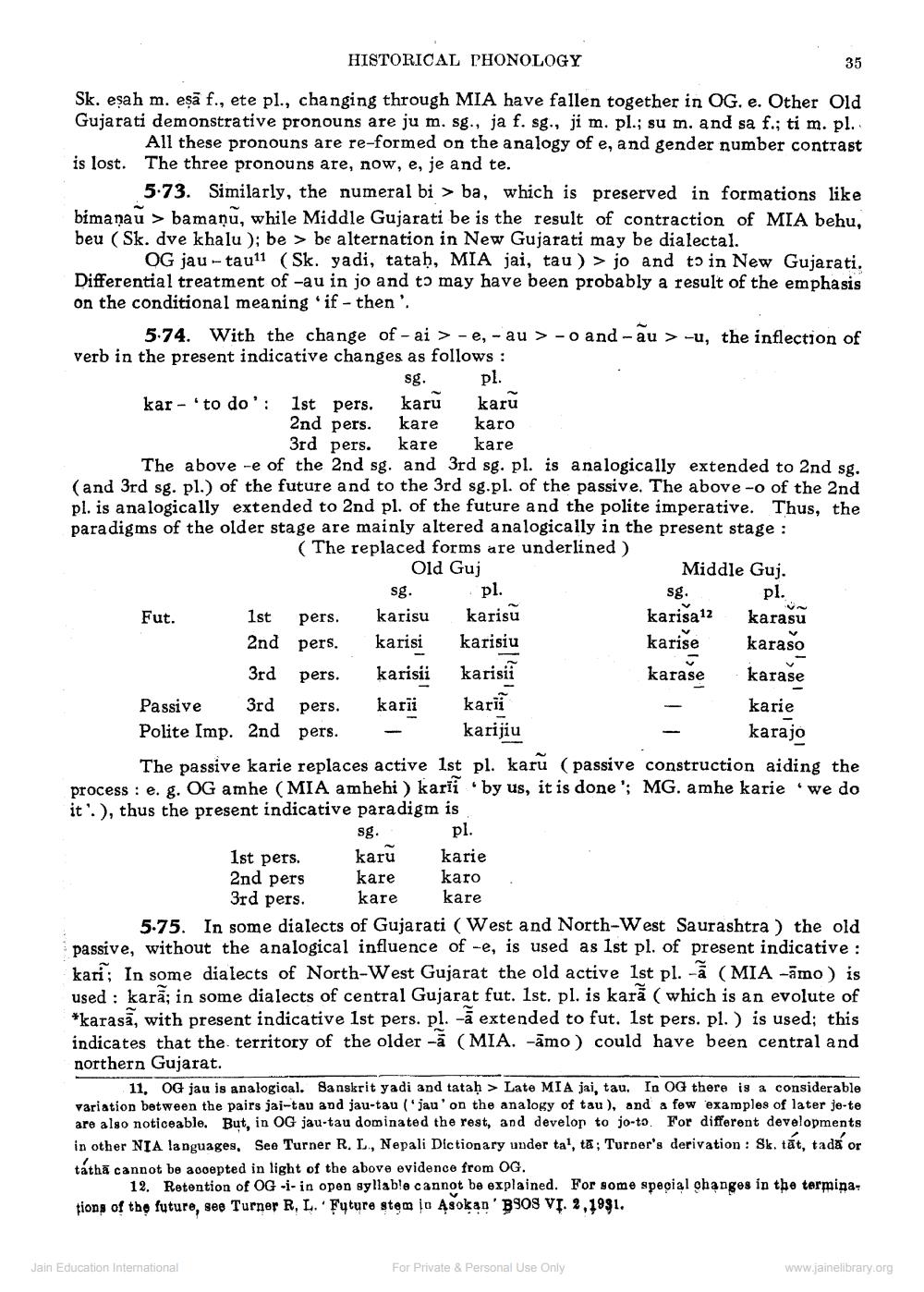________________
HISTORICAL PHONOLOGY
35
Sk. eșah m. eșā f., ete pl., changing through MIA have fallen together in OG. e. Other Old Gujarati demonstrative pronouns are ju m. sg., ja f. sg., ji m. pl.; su m. and sa f.; ti m. pl.
All these pronouns are re-formed on the analogy of e, and gender number contrast is lost. The three pronouns are, now, e, je and te.
5.73. Similarly, the numeral bi > ba, which is preserved in formations like bimaņau > bamaņu, while Middle Gujarati be is the result of contraction of MIA behu, beu (Sk. dve khalu ); be > be alternation in New Gujarati may be dialectal.
OG jau-tau11 (Sk. yadi, tatah, MIA jai, tau ) > jo and to in New Gujarati. Differential treatment of -au in jo and to may have been probably a result of the emphasis on the conditional meaning 'if - then'.
5.74. With the change of -ai > -e, -au > - and-au >-u, the inflection of verb in the present indicative changes as follows:
sg. pl. kar - 'to do': 1st pers. karu karu
2nd pers. kare karo
3rd pers. kare kare The above -e of the 2nd sg. and 3rd sg. pl. is analogically extended to 2nd sg. (and 3rd sg. pl.) of the future and to the 3rd sg.pl. of the passive. The above-o of the 2nd pl. is analogically extended to 2nd pl. of the future and the polite imperative. Thus, the para digms of the older stage are mainly altered analogically in the present stage :
(The replaced forms are underlined ) Old Guj
Middle Guj. sg. pl.
sg. pl. Fut. 1st pers. karisu karisu
karisa12 karasu 2nd pers. karisi karisiu
karise
karaso 3rd pers. karisii karisii
karase karase Passive 3rd pers. karii k arii
karie Polite Imp. 2nd pers.
karijiu
karajo
V
The passive karie replaces active 1st pl. karu (passive construction aiding the process : e. g. OG amhe (MIA amhehi karii.by us, it is done'; MG. amhe karie we do it'.), thus the present indicative paradigm is
sg. pl. 1st pers. karu karie 2nd pers kare karo
3rd pers. kare kare 5.75. In some dialects of Gujarati (West and North-West Saurashtra ) the old passive, without the analogical influence of -e, is used as Ist pl. of present indicative : kari; In some dialects of North-West Gujarat the old active 1st pl. - (MIA -āmo) is used : karā; in some dialects of central Gujarat fut. 1st, pl. is karā (which is an evolute of *karasā, with present indicative 1st pers. pl. -ā extended to fut. 1st pers. pl.) is used; this indicates that the territory of the older -ā (MIA. -āmo) could have been central and northern Gujarat.
11, OG jau is analogical. Sanskrit yadi and tataḥ > Late MIA jai, tau. In OG there is a considerable variation between the pairs jai-tau and jau-tau ('jau' on the analogy of tau), and a few examples of later je-te are also noticeable. But, in OG jau-tau dominated the rest, and develop to jo-to. For different developments in other NIA languages, See Turner R. L, Nepali Dictionary under ta' ta; Turner's derivation : Sk. tát, tadá or tátha cannot be accepted in light of the above evidence from OG
12. Retention of OG -- in open syllable cannot be explained. For some special changes in the termina. tions of tho future, see Turner R, L. Future stem jo Asokan' BSOS VI. 2,1931.
Jain Education International
For Private & Personal Use Only
www.jainelibrary.org




